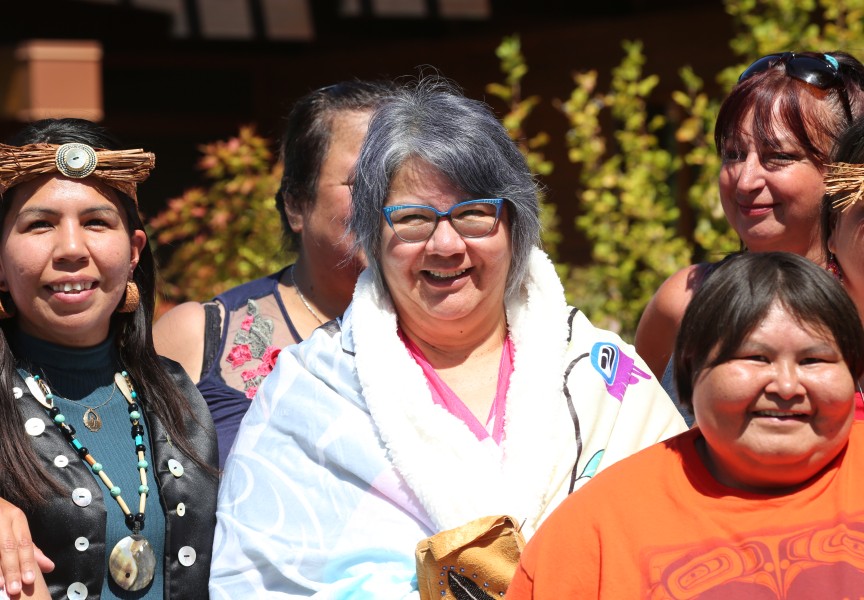“I am honored to be here to hear these witness statements regarding this horrific crime, which in my mind reeks of cruelty and injustice.”
The statement was part of the address by Dr. Dorothy Sam Williams, chief of staff at West Coast General Hospital and chair of the Vancouver Island Physicians Advisory Committee, as part of her presentation to the forum held on the human biomedical experiments conducted at Alberni Indian Residential Schools (AIRS) in the 1940s and ‘50s.
The forum was hosted Dec. 11 by Tseshaht First Nation and the Nuu-chah-nulth Tribal Council.
Dr. Williams spelled out an entire shopping list of life-long health effects that can result from the kind of childhood malnutrition experienced by students at residential schools across the country.
“We are talking about children chronically malnourished in residential schools as a result of government policies,” Williams said. “The conditions in these schools damaged children and their families and resulted in the loss of traditional ways at a crucial time when children are establishing healthy food habits.”
Residential school survivors who attended the forum at Maht Mahs gym learned that systemic malnutrition was a fact of life at all of Canada’s residential schools, far beyond the notorious “Hunger Experiments” that took place from 1947 to 1952.
In his presentation, University of Guelph researcher, Dr. Ian Mosby, was blunt: residential school students were deprived of adequate nutrition as a matter of federal government policy, due to underfunding.
“Today is a historic day for all of us,” Williams said, in thanking Tseshaht and NTC for making the forum a reality. Williams said she was moved by the statements given during the question-and-answer sessions.
Not having access to healthy foods can disrupt the transfer of “food skills” to children, she explained. When those children grow up, they are unable to transmit those skills to their own children, setting up a multi-generational effect.
Williams is a specialist in gerontology, treating patients over 70 years of age. Over the years, she has treated many victims of childhood malnutrition: those who lived through the food shortages of the Second World War, refugees, concentration camp survivors and yes, residential school survivors.
“The diseases of malnutrition can be healed. The mental disruption is harder to deal with,” Williams said.
Some of those “legacy” diseases, such as osteoporosis, diabetes and high blood pressure, can be treated with medication.
“But when you are malnourished as a child, you can suffer from anxiety, depression and abnormal relationships with food. I see some of you are nodding…
“It is entirely reasonable to want to hoard food if you were starved as a child; that is not your fault.”
Williams noted that several audience members were miming a frantic search for food in purses and nearby bags to demonstrate that they understood exactly what “abnormal relationships with food” meant.
Overeating is another frequent aftereffect of childhood malnutrition, Williams explained. A child may lose the correct cues of when to eat and when to stop eating.
On one hand, after damping down hunger cues out of necessity for many years, the cycle can be extremely hard to break. And when you never get enough to eat, you never learn what it feels like to be full, so you keep eating.
Williams presented a series of slides, including one spelling out the long-term impacts of withholding food during early childhood, include metabolic syndrome, hyperglycemia, Type 2 diabetes, high blood pressure, cardiovascular disease and stroke. According to research, the consumption of abundant high-calorie/low-nutrition “modern” foods later in life increases the risk of developing one or more of these diseases.
That underscored the statements of numerous survivors, who described a litany of health problems they are dealing with, including most of the above.
But perhaps overshadowing their current struggles with diabetes and heart disease and any number of ailments, it was the anger and the anxiety surrounding food that the survivors wanted to convey.
Ray Silver, 84, was sent to AIRS from his home in the Fraser Valley.
“I never learned my ABCs here. I never learned how to read and write. I learned how to steal food,” Silver said. “When I left, I said, ‘If this is what school is all about, I’ll never go to school again.’
“I became what the white people said I would: a drunken Indian. But I wasn’t a lazy one.”
Silver worked at a brick factory from the age of 15 until his retirement. He spoke of the corrosive hatred that drove him for many years, and undoubtedly affected his relationships with his 11 children.
But now, Silver spends his time speaking to both First Nations and non-aboriginal children and organizations, building bridges between his culture and the society that oppressed him. For his efforts, he has received an honorary PhD.
Tom Curley said he has always brooded over the twin effects of the racist attitudes he endured at the school, coupled with the debilitating effects of the malnutrition.
“I have always wondered about the long-term effect on my mental abilities,” Curley said.
Despite consistent feedback confirming that he has more than adequate intellectual and verbal skills, Curley said that curse of “Stupid good-for-nothing Indian,” exacerbated by the anxieties fostered by childhood hunger, has always stayed in the back of his mind.
Tla-o-qui-aht member Alice George summed up her feelings succinctly:
“Our people are not stupid – we’re damaged.”
Part of that damage is cultural, according to the Dieticians of Canada. Survivors were unable to learn the cultural meaning of food and those “food parenting” skills that must be passed down in order to have healthy families.
That ingrained fear of wasting food is another debilitating factor that can affect multiple generations.
Williams shared her own experience as a child whose parents went through hungry times in the United Kingdom during the Second World War.
“As a child, I was not allowed to leave the table until my plate was cleaned,” she said, adding that the anxiety level was always apparent.
According to the Dieticians of Canada, it is now accepted that parents should be the ones who choose the family foods, because they are the ones who are expected to know about the culture and about nutrition. But children should be the one to choose about how much to eat, because they know how much food it takes to satisfy them.
By contrast, that “clean your plate” model used at the residential schools and in homes with faulty relationships with food, trains children to ignore their internal hunger and fullness cues and, as a result, to overeat.
If the damage is cultural, Williams said. So is the cure.
The Indigenous Food Systems Network (http://www.indigenousfoodsystems.org/) has, since 2007, conducted an ongoing program called Feasting for Change, which has brought together health professionals and aboriginal communities to share traditional food knowledge through feasting.
Williams also suggested survivors and their families also check out the Vancouver Island and Coastal Communities Indigenous Foods Network (http://www.indigenousfoodsvi.ca/), which held its Sixth Annual Traditional Foods Conference in September.






